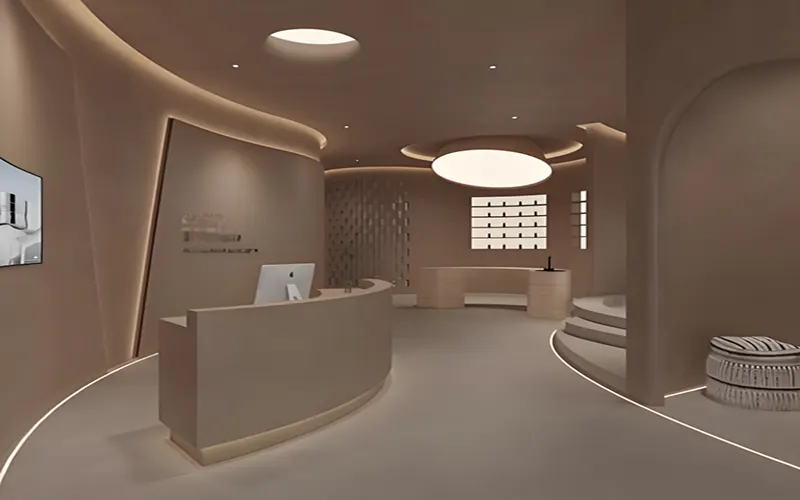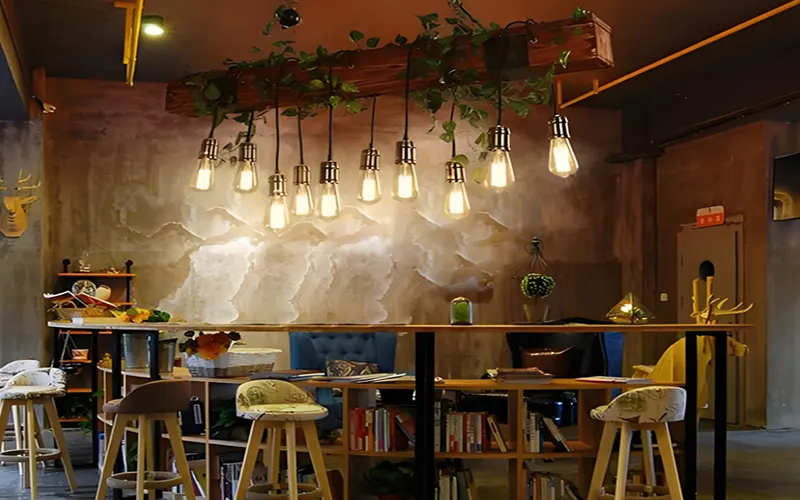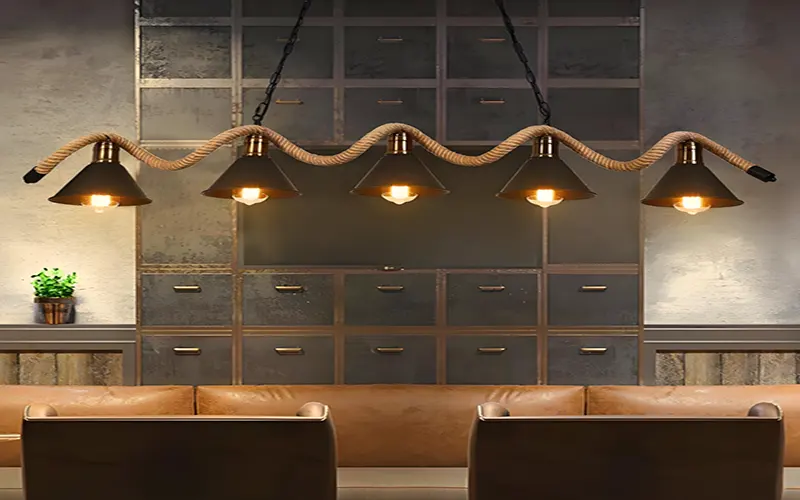
In 2025, with the emergence of new and innovative lighting, we know that store lighting is no longer simply about “brightening the space” but has become one of the most crucial components of space design. It not only impacts the presentation of merchandise but also directly influences the customer experience and spending desire. This article will provide a detailed explanation of shop lighting ideas innovation, introducing you to the key aspects and latest innovations.
What Lighting Fixtures can Be Used in Shop Lighting?
Modern store lighting typically consists of three main components, and most lighting has three main uses: basic lighting, accent lighting, and ambient lighting. However, the corresponding lighting fixtures vary.
- Track spotlights: These are the most common accent lighting tools in retail stores. Mounted on a track, they can be flexibly adjusted and used to highlight new products, mannequins, or promotional areas.
- Recessed downlights and grille lights: Installed in the ceiling, they provide a uniform, basic light source, ensuring uniform brightness throughout the space and eliminating dark corners.
- Chandeliers and decorative lights: These types of lights are primarily used for decorative purposes. They are primarily used in coffee shops and boutique clothing stores to create a personalized style.
- LED strip lights: They can be installed on shelves, display cases, and ceiling edges, often serving as ambient lighting to add a sense of depth to merchandise.
- Panel lights/linear lights: They are suitable for areas requiring large, evenly illuminated areas, such as checkout counters and open office spaces.
- Customized neon signs or branded signage: They enhance brand recognition and also convey a sense of luxury.
Where Should Different Lighting Fixtures Be Installed in a Shop Lighting Ideas?
Design perspectives vary from store to store. The following examples illustrate common design styles.
- Entrances and windows: Track spotlights or LED floodlights can be used to attract customers’ attention.
- Aisles: Downlights or grille lights can be placed in aisles to ensure comfortable movement.
- Shelves and display cases: Recessed or backlit LED strip lights can highlight product details.
- Checkout counters: Pendant lights or spotlights can create focal points.
- Lounge/waiting areas: Warm-light pendant lights or wall sconces can create a relaxing atmosphere.
What Should I Consider When Choosing Store Lighting?
First, consider the nature of the store and what it sells. Different types of stores require different lighting options. Furthermore, when choosing lighting, don’t just consider price or brightness; consider customer experience and the store’s operational needs.
Energy efficiency and lifespan: These are crucial. Regardless of the LED lighting you choose, choosing high-efficiency LEDs reduces energy consumption and long-term maintenance costs. Specifically, this means lowering your electricity bill and reducing the cost of the lighting.
Color Rendering Index (CRI): A CRI of 90 or higher is ideal, ensuring the colors of clothing, cosmetics, food, and other items are rendered faithfully and accurately.
Glare: Direct light can be glaring, so choose lamps with anti-glare features or use a sunshade.
Beam angle: This determines the light’s coverage area. Small angles (15–30°) are suitable for highlight displays, while large angles (60–90°) are suitable for large areas.
Flexibility: Displays are frequently adjusted, especially in fashion and retail stores, so track lights and adjustable-angle lamps are more practical.
How to Design Creative Store Lighting?
When planning store lighting, the key is to ensure that all lighting is harmonious, without any one feature standing out. A successful lighting design generally follows the “three-layer light” principle:

Primary Lighting
Primary lighting, such as downlights and panel lights, ensures uniform brightness across the space, allowing customers to navigate and browse. Currently, we’ve found that panel lights and ceiling-mounted fixtures are more commonly used for primary lighting.
Accent Lighting
We can use track lights or spotlights to highlight merchandise, naturally drawing customers to new products or high-profit areas.
Ambient Lighting
Currently, there’s a growing focus on ambient lighting in store decorations, creating a comfortable and inviting atmosphere. LED light strips, neon lights, wall lamps, and other lighting can be used to create an atmosphere or highlight a brand’s unique characteristics.
Consider the Following When Designing Lighting
- Traffic Guidance: The brightness and darkness of light can serve as “invisible signposts,” guiding customers from the entrance to the core display area and then to the cashier.
- Zone Lighting: Children’s areas can use soft warm light, electronics areas are suitable for cool light, and the coffee area should use warm-toned pendant lights.
- Brand Tone: Luxury stores often use 3000K warm light to create an elegant atmosphere, while technology stores prefer cool light between 5000K and 6500K.
Which is Better for Stores: 5000K or 6500K?
Different color temperatures are suitable for different locations. Both 5000K and 6500K fall into the cool light category.
- 5000K: Close to natural daylight, clear but not glaring, suitable for most retail environments (apparel, beauty, and restaurants), ensuring color reproduction while creating a comfortable atmosphere for customers.
- 6500K: Cooler and brighter, suitable for electronics, eyewear, and digital experience stores, highlighting a sense of technology and a rational consumption atmosphere.
Conclusion: If there are no special requirements, 5000K is the most versatile choice; if a cool color scheme and a technological atmosphere are desired, 6500K is the preferred choice.
How Many Lumens are Needed to Illuminate a 30×40 Store?
Store Area: 30 × 40 = 1200 square meters.
Recommended Illumination: 500–750 lux (lx) is recommended for retail spaces.
Total Lumens Required: 1200 × 500–750 = 600,000–900,000 lumens.
Lamp Quantity Example: If using 30W LED spotlights, each with approximately 3000 lumens, you’ll need approximately 200–300 fixtures, combined with downlights and light strips, to achieve both bright and layered lighting.
2026 Shop Lighting Ideas Worth Considering
Below are 10 examples of shop lighting ideas you can consider.

1. Dynamic Window Lighting Display
Location: Exterior shop windows.
Lighting: RGBW track lights, DMX512 or SPI LED strips.
Application: Use an intelligent control system to set different color temperatures and color changes to match the window display theme (such as holidays or seasonal new products).
Effect: The window becomes a “living advertisement,” attracting customers from afar.
2. Use LED strip lights to outline the entrance.
Location: Doorways, floors, or ceiling moldings.
Lighting: Waterproof LED strips, aluminum recessed light troughs.
Application: Use linear lights to guide customers toward the door or checkout counter.
Effect: Provide visual guidance and enhance overall quality, making the store more visible from the street.
3. Product Accent Lighting
Location: Shelves, display stands, mannequins. Lighting: Adjustable LED spotlights and low-voltage track lights.
Application: Focus on star products or high-profit items, using an angle of 30°–45° to avoid strong glare.
Effect: Creates contrast, directing customers’ attention to the recommended products.
4. Interactive Light Wall
Location: Background wall in featured display areas or rest areas.
Lighting: Programmable LED modules and pixel light strips.
Application: Light changes as customers approach (triggered by sensors) or displays dynamic patterns.
Effect: Enhances the sense of technology and user experience, particularly suitable for younger consumers.
5. Hidden Ceiling Light Troughs + Layered Lighting
Location: Peripheral and central areas of the ceiling.
Lighting: Recessed light strips and surface light sources.
Application: Use perimeter lighting troughs and centrally located spotlights to create a combination of primary and secondary lighting.
Effect: Creates a more layered space, reduces the sense of oppression often associated with single ceiling lights, and encourages customers to stay longer.
6. Soft Lighting in Fitting Rooms
Location: Top and side mirror frames in fitting rooms.
Lighting: High color rendering index (CRI>90) soft light strips or panels.
Application: Avoid direct overhead lighting and use surround lighting to simulate natural light.
Effect: Customers see a more natural skin tone and clothing in the mirror, which increases conversion rates.
7. Warm Focus Lighting at the Checkout Counter
Location: Above the checkout counter.
Lighting: 3000K–3500K pendant lights or small spotlights.
Application: Focus on brightening the checkout area while controlling brightness to avoid excessive glare.
Effect: Provide customers with a warm and reassuring checkout experience, reducing the anxiety of waiting in line.
8. Ceiling Grille Lighting for an Industrial Style
Location: Entire ceiling.
Lighting: Black grille lights and adjustable spotlights.
Application: Combined with the exposed ceiling design, the lighting creates a more discreet feel. Effect: Creates a clean, minimalist space, highlighting a trendy and fashionable vibe, particularly suitable for clothing and trendy brand stores.
9. Fragrance + Lighting Experience Zone
Location: Lounge area, next to the sofa, or near a display stand.
Lamp: Small ambient lighting, soft desktop lighting.
Application: Paired with a fragrance diffuser, localized warm light emphasizes comfort.
Effect: Increases customer dwell time and enhances the immersive experience, particularly suitable for boutiques and cafes/retail spaces.
10. Seasonal/Holiday Themed Lighting
Location: Storewide.
Lamp: Smart dimming lamps, bi-color LED strips.
Application: For Christmas, choose a warm white/red/green combination; for summer, cool white/blue tones; and for Valentine’s Day, a pink-tinted light is ideal.
Summary
Shop lighting ideas innovations in 2026 will focus on “experience + guidance + atmosphere.” Lighting clarity will no longer be the primary focus. We need to focus not only on illumination but also on tools that attract customers, extend their stay, and encourage purchases. The rational use of track lights, light strips, surface light sources and intelligent control can transform a store from an ordinary one into an attractive and relaxing space.
